 Dislikes: 0
-
Recommendations on polishing products to start with?
Hi all!
I have a black 2016 Mazda 3 S GT that I'd like to learn to care for a little better! I bought the car as a CPO and it was already in pretty good shape, and I've been following the 2-bucket wash method with Meguiar's products for wash, tire clean/dressing, and spray wax, and I also have a clay bar kit/decon spray etc. But I've always wanted to try my hand at paint correction and polishing. The Mazda, being a black car, has the normal amount of swirls and stuff from it's 3 years with a P.O. who probably used typical auto washes. I have the Griot's G9 Polisher+M105/M205 Combo on order with Autogeek as my first polisher! But there's a few things I need to find out.
First off, I do not have a garage or shady environment to work in, will the M105/M205 be unusable for me? If so, what would be good to use in it's place?
Since the car isn't in terrible shape by any means, I was assuming I was going to start with an orange or white pad on the 205 and then wax after that, any recommendations for Mazda paint?
Lastly, should I be looking at the D300/302/301 series line with a MF pad as opposed to the M105/M205 with foam pads? What's the difference?
Thanks!
-
Super Member

Re: Recommendations on polishing products to start with?
My experience with M105/205 is plenty of dust created no matter how often I cleaned the pads. M210 and M110 were or are supposed to dust less. No experience with the M210 or 110
Sent from my SM-N960U using Tapatalk
-
Super Member

Re: Recommendations on polishing products to start with?
Do a test spot with M205 and go from there. I would actually recommend a different compound over M105. Avoid the frustration of using it especially in the sun and either invest in M110 or ultimate compound if you want to stay with the Meguiar's family. I have not worked on Mazda paint and if it is soft well that is where M205 struggles. M210 does a better job of that but does not have as much cut as M205.
D300 is a great compound. It was designed for the microfiber cutting pad. It does a pretty good job on foam pads. The microfiber pad will offer more cut but of the paint is soft will leave micro-marring.
D302 is a non-abrasive polish. It is essentially used a lubricant between the polishing pad and the paint where the pad is doing all the work. I found that this does not finish out to well on soft paints.
D301 is the finishing wax which falls into the AIO category. Not the longest lasting protection. But it depends on what you are looking for. It can also be used with a foam pad.
You probably don't need the microfiber system. The issue you will probably have with any product is working in the sun.
-
Post Thanks / Like - 1 Thanks, 0 Likes, 0 Dislikes
-
Re: Recommendations on polishing products to start with?
I was thinking I'm going to have either get a canopy work under or wait for an overcast day/later in the evening anyhow.
It sounds like the D300/301/302 might not be for me then. But I am confused as to why the 210 does better than the 205 if it cuts less?
-
Re: Recommendations on polishing products to start with?
I'll chime in with some help...
Read through here, there's some tips you can use.
Tips for working in warm/hot weather or direct sunlight


-
Post Thanks / Like - 1 Thanks, 0 Likes, 0 Dislikes
-
Re: Recommendations on polishing products to start with?
More.....
The below is some real meaty info you'll only find on a forum.
From this article,
Here's what you need to get into machine polishing - Recommendations for a beginner by Mike Phillips
en using a one-step cleaner/wax you're done after the first and only step so you don't need more pads.
Foam pads versus microfiber pads
Here's the primary difference if you're new to machine polishing and don't know which style of pad to go with.
You can quote me on this statement,
When comparing foam pads to microfiber pads, foam pads will finish out nicer and more consistently on a wider spectrum of paint systems - Mike Phillips
What this means is, cars have paint on them. The paint comes from a paint manufacturer. There are about a dozen paint manufacturers that provide paint to car manufacturers and the re-finishing industry. (re-finishing industry is the local body shop or dealership that fixes the dents in your car and sprays fresh paint on the repaired area so it matches the rest of the car.
Paint systems are not only different in their hardness and softness, or what I like to call polishability, but paints are ALWAYS changing. So there's no simple way to know if the paint you're buffing on is hard or soft without testing and experience, (I cover this in my how to book on page 7)
So when I say, that foam pads will finish out nicer and more consistently on a wide spectrum of paint systems that means
A: For the finishing step, not the compounding step. (look at what I wrote)
B: I used the words wide spectrum because thousands of people will read this and then be buffing on a car somewhere and it will have a "paint system" on it and none of us except the person buffing on this car will know if the paint is hard, soft or somewhere in-between.
Fibers are a form of abrasive
Just like the headline reads, fibers are form of abrasive. A gentle abrasive in most cases but an abrasive all the same. If you put a wool cutting pad on a rotary buffer and then buff on some black paint with some baby oil, after you strip the paint of the baby oil and look at the paint there will be hologram swirl scratches in the paint. They will not have come from the baby oil or the tool, so what put the scratches into the paint? Answer. The fibers that make up the wool pad.
You can extrapolate this out to microfiber pads for orbital polishers. While for some paints, (harder paints), you can both compound and finish out with a fiber/microfiber pad, for other paints, (softer paints), you can compound with a microfiber pad and remove defects but the fibers that make up the pad can and will leave a scratch pattern called micro-marring. That's okay if you do a follow-up step after compounding and re-polish the paint but if you're seeing micro-marring from a microfiber pad then you'll have a high chance of finishing out without micro-marring if you switch over to a foam pad.
And the above explanation is what I mean when I say,
"When comparing foam pads to microfiber pads, foam pads will finish out nicer and more consistently on a wider spectrum of paint systems"
Of course, you never know what you can do until you try.... and then inspect the results. And when inspecting, to measure the true and accurate results you'll need to chemically strip the paint and inspect with a quality swirl finder light or bright overhead sunlight.
Car Detailing History 101
To help understand the history of microfiber pads and when and why they were introduced into the car detailing world, I like to use the Meguiar's Microfiber DA Correction System as an analogy.
Meguiar's introduced this system to change the production detailing industry by getting rid of the universally abused rotary buffer. The production detailing industry uses the rotary buffer for SPEED, not quality. The problem with the rotary buffer is that all to often it leaves the paint filled with holograms.
Holograms = a circular scratch pattern IN the paint caused by the single rotating action of the buffing pad on a rotary buffer.
Holograms mimic the pattern a rotary buffer is moved over the paint. Holograms is a SPECIFIC type of scratch pattern only inflicted into paint by rotary buffers, not orbital polishers. Orbital polishers can instill micro-marring and a visible pattern of how an orbital buffer was moved over the paint can be seen on darker colors but this pattern is NOT called holograms. You can call it buffer trails, or buffer haze or buffer shadows, or buffer patterns but it is NOT called holograms.
The idea was to replace the rotary buffer with a free spinning orbital polisher from Meguiar's called the G100 which was a copy of the Porter Cable 7424 orbital polisher, and then later the MT300, which offers the same 8mm orbit stroke length has the G100 (or the Porter Cable), but has a longer body than the G100. (same 8mm free spinning orbital polishing action)
To make up for the loss of direct drive power and speed offered by the rotary buffer, Meguiar's incorporated a microfiber pad or a FIBER pad to assist in faster defect removal. Or you could say this as faster PAINT REMOVAL as removing defects is actually removing paint to level the surface, that is level the surface with the lowest depths of the defects you're trying to remove to create a visually flat and also visually perfect finish. The fibers act as a form of abrasives and aid the actual abrasives in compounds and polishes.
The downside of increasing the aggressiveness or cutting ability of an orbital polisher by introducing a microfiber pad is the risk of introducing micro-marring when the fibers instill their own scratch pattern into some paints, typically softer paints. This tradeoff is considered a net gain as compared to having the detailing industry inflict every car buffed out with a rotary buffer with hologram scratches.
The above is an attempt to explain not only why there are microfiber pads on the market but where they fit into the car detailing or car buffing processes.
Foam pads reduce the risk of micro-marring because they offer a uniform texture of the entire face of the pad, not individual fibers, or loops of fibers in the case of some brands of microfiber pads.
You won't know if a microfiber pad will induce micro-marring into the paint of any car you are going to buff out until you do a Test Spot. One option for detailers that want increased cutting from any free spinning orbital polishers is to START with microfiber pads for the compounding or cutting step but finish with foam pad.
Besides pads, abrasive technology is a HUGE factor as to whether you will see micro-marring or not no matter what type of pad you use. This is why I believe the most important factor when buffing out a car is the abrasive technology, not a person's technique, not the tool or the pad. It all starts with the substance TOUCHING the paint and in the car detailing world this would include,
- Compounds
- Polishes
- Cleaner/waxes --> most cleaner/waxes, or cleaner/sealants contain some form of abrasive technology like compounds and polishes and this is why I include them in this group of substances that touch the paint.
So when it comes to pad choices, in a nutshell,
1: If you find your car has medium to soft paint, you may be able to start with a microfiber pad but you'll need to finish with a microfiber pads to avoid micro-marring, or micro-scratching.
2: If you find your car has hard paint, you might be able to both start and finish with a microfiber or micro-wool pad. Only a Test Spot will tell you what you can do. You should also chemically strip the paint and inspect with bright overhead sunlight and/or a swirl finder light to make sure there's no hidden micro-marring.
3: If you don't know what kind of paint is on your car, hard or soft, the stick with foam for cutting, polishing and finishing.
4: If you're using an AIO also called a cleaner/wax or cleaner/sealant or up and coming, primers, then stick with foam.
Hope this helps.....

-
Post Thanks / Like - 1 Thanks, 0 Likes, 0 Dislikes
-
Re: Recommendations on polishing products to start with?
And....
On the topic of detailing cars. EVERYONE, yours truly included, should always do a Test Spot anytime we're buffing out a car we've NEVER worked on before.
Please read through this - it is meaty to and only something you'll find on a forum like this.
The two reasons WHY you should always do a Test Spot before buffing out any car

-
Post Thanks / Like - 1 Thanks, 0 Likes, 0 Dislikes
-
Re: Recommendations on polishing products to start with?
And one more resource for ANYONE that is NEW to MACHINE polishing with any brand and type of orbital polisher.
How to do a Test Spot and then buff out your car! Video Explanation by Mike Phillips

-
Post Thanks / Like - 1 Thanks, 0 Likes, 0 Dislikes
-
Re: Recommendations on polishing products to start with?
 Originally Posted by ebrammer252

Hi all!
I have a black 2016 Mazda 3 S GT that I'd like to learn to care for a little better!
I have the Griot's G9 Polisher+M105/M205 Combo on order with Autogeek as my first polisher!
Great starter kit. You'll want to get more pads. For any correction step or anytime you're using an AIO to correct paint, you need about 6 pads minimum.
Here's what you have in your kit,
Kit includes:
Griot’s Garage G9 Random Orbital Polisher
8 oz. Meguiars Mirror Glaze #105 Ultra-Cut Compound
8 oz. Meguiars Mirror Glaze #205 Ultra Finishing Polish
CCS Orange Light Cutting Foam Pad, 6.5 inches
CCS White Polishing Foam Pad, 6.5 inches
CCS Black Finishing Foam Pad, 6.5 inches
2 Microfiber Polishing Towels (16 x 16 inches)
 Originally Posted by ebrammer252

Since the car isn't in terrible shape by any means, I was assuming I was going to start with an orange or white pad on the 205 and then wax after that, any recommendations for Mazda paint?
Test the white pad with the M205 on a section of paint about the size of one of the microfiber towels laid out on one half of the hood or trunk lid. You want to test on a horizontal surface that's flat that you can look down on and expose to bright sunlight in order to best inspect.
WATCH the video I linked to it will show you EXACTLY how to run the polisher over the 16" by 16" section. You'll do this on the 5 to 6 speed setting with about 5 pounds of downward pressure and a SLOW arm speed.
Do this - and then report back with what you see. It's always good to get info first - hank you for joining the AGO forum to ask your questions. I will put the information you get here to learn how to machine polish your car up against ANY other source of info on the net.
But after getting some info - at some point - you need to fire up the polisher and do a Test Spot.

-
Post Thanks / Like - 1 Thanks, 0 Likes, 0 Dislikes
-
Re: Recommendations on polishing products to start with?
One more thing.....
How to Monitor Pad Rotation? Mark Your Buffing Pads
Anytime you're using a free spinning orbital polisher there is the chance that the buffing pad can slow down and if stall out to the point where there's simple no pad rotation. When this happens you are no longer removing paint defects at an effective rate, if at all. Paint defects like swirls, scratches, water spots and oxidation are removed best, fastest and most effectively when the pad is both rotating and oscillating against the surface.
It used to be you could simply place a mark on the back of the backing plate and by doing this your eyes could easily monitor pad rotation by looking at the backing plate. Now days a lot of tools have dark or black backing plate making it hard to mark and hard to see. Some backing plates are very thin or exact fit and there's simply very little backing plate surface area to mark and thus monitor. And some tools have a protective cover or shroud over the top of the backing plate covering up the majority of the backing plate blocking your view.
Here's a very simple fix - mark your buffing pads
Use a combination of Sharpie Markers, both Black and Silver and also touch-up paint can be used.
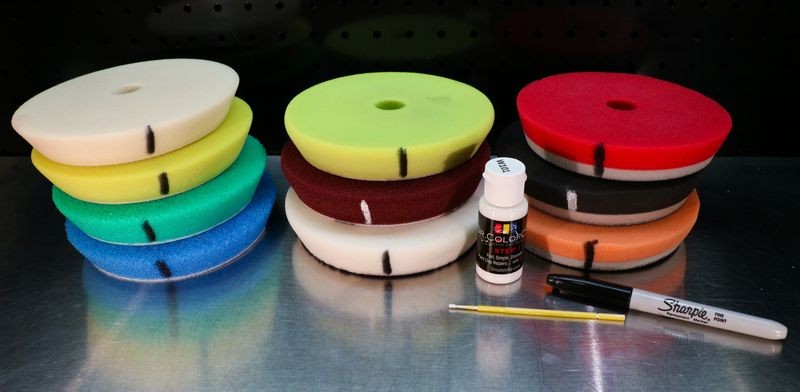
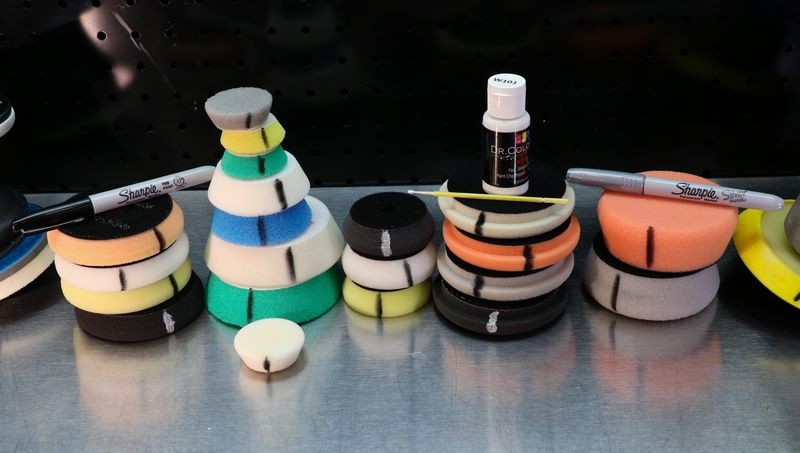
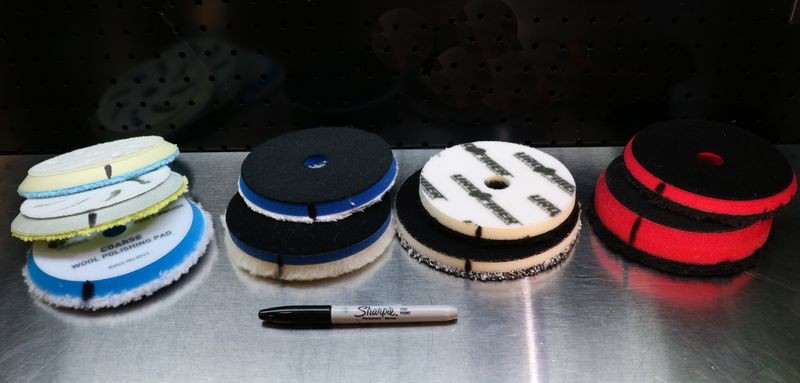
Here are some very popular free spinning orbital polishers with the pads marked.

These marks on the side of the pad will make it very easy for you to monitor pad rotation.
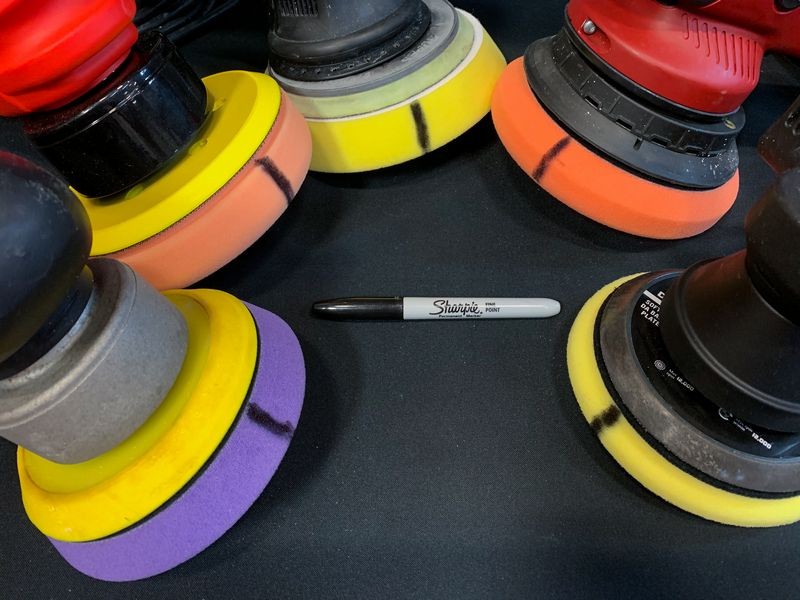
When using free spinning orbital polishers - pad rotation is necessary for effective defect removal
You should also mark your backing plates. Pad rotation is necessary for effective defect removal. You need to be able to EASILY see if the pad is rotating. By marking both the side of your buffing pads and the backing plate it will be fast and easy to see and monitor pad rotation.
Here's a Black Sharpie for marking light colored backing plates
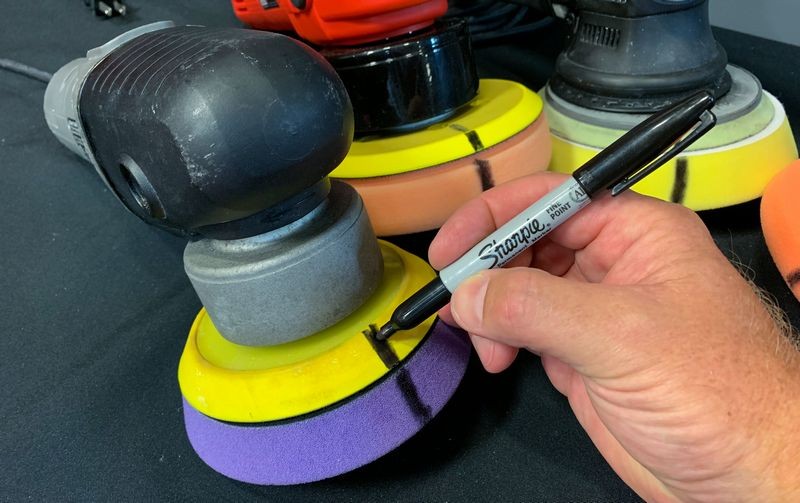
A Silver Sharpie works great for a black backing plate.
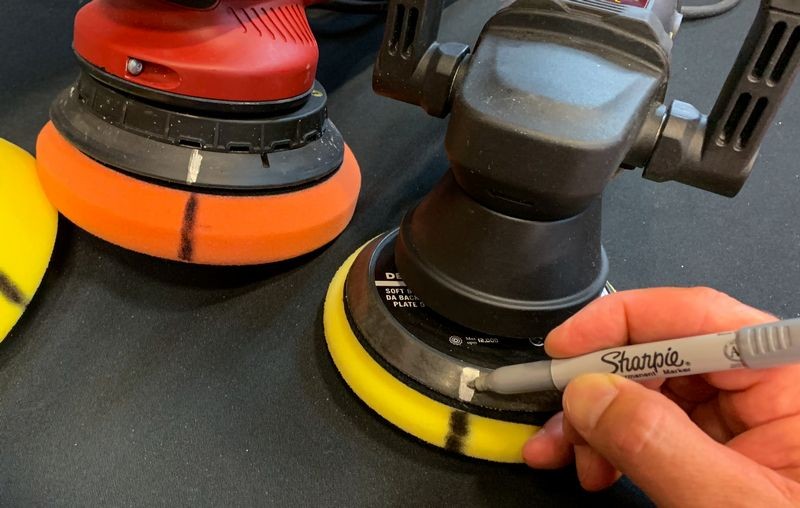
This is how the backing plates and pads should look on your free spinning orbital polishers.



The little things are the BIG THINGS!
Even though this is an incredibly simple fix, sometimes the little things are the big things and in order to be working at maximum efficiency anytime you're doing correction or polishing work with any free spinning orbital polisher you want to visibly see pad rotation. As simple mark on the side of your buffing pad will make it a lot easier for your eyes to monitor for pad rotation.
If you don't see pad rotation then you need to change something, perhaps the way you're holding the tool, the speed your buffing at or if your pad is becoming saturated with product, switch to a clean, dry pad. Wet pads on free spinning orbital polishers don't rotate well. This is one reason it's a good idea to have plenty of buffing pads ready to go before starting any full correction detail.

-
Post Thanks / Like - 1 Thanks, 0 Likes, 0 Dislikes
Similar Threads
-
By Tim McCreary in forum Auto Detailing 101
Replies: 13
Last Post: 09-13-2019, 12:50 PM
-
By uhohitsstevo in forum Auto Detailing 101
Replies: 40
Last Post: 05-05-2016, 07:48 AM
-
By captainsquirts in forum Auto Detailing 101
Replies: 27
Last Post: 04-08-2016, 06:50 PM
-
By Mike Phillips in forum Ask your detailing questions!
Replies: 3
Last Post: 08-12-2015, 01:12 PM
-
By neverman in forum Auto Detailing 101
Replies: 11
Last Post: 02-14-2007, 05:04 PM
 Members who have read this thread: 0
Members who have read this thread: 0
There are no members to list at the moment.
 Posting Permissions
Posting Permissions
- You may not post new threads
- You may not post replies
- You may not post attachments
- You may not edit your posts
-
Forum Rules
|
| S |
M |
T |
W |
T |
F |
S |
| 31 |
1
|
2
|
3
|
4
|
5
|
6
|
|
7
|
8
|
9
|
10
|
11
|
12
|
13
|
|
14
|
15
|
16
|
17
|
18
|
19
|
20
|
|
21
|
22
|
23
|
24
|
25
|
26
|
27
|
|
28
|
29
|
30
| 1 | 2 | 3 | 4 |
|












 Thanks:
Thanks:  Likes:
Likes:  Dislikes:
Dislikes: 

 Reply With Quote
Reply With Quote



Bookmarks